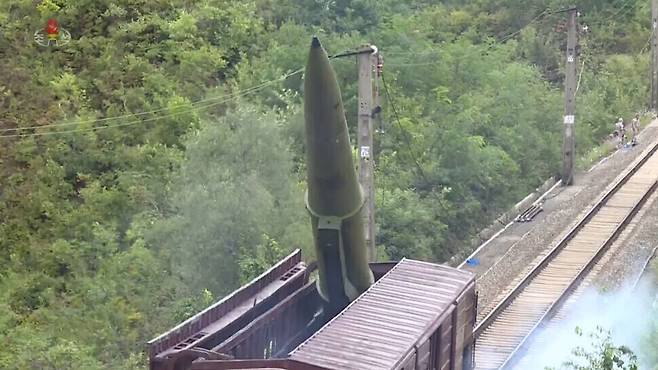Why did N. Korea fire a missile days after Kim Yo-jong hinted at inter-Korean talks?
이 글자크기로 변경됩니다.
(예시) 가장 빠른 뉴스가 있고 다양한 정보, 쌍방향 소통이 숨쉬는 다음뉴스를 만나보세요. 다음뉴스는 국내외 주요이슈와 실시간 속보, 문화생활 및 다양한 분야의 뉴스를 입체적으로 전달하고 있습니다.

North Korea fired a missile toward the East Sea just three days after Workers’ Party of Korea (WPK) Central Committee Deputy Director Kim Yo-jong issued a statement on Saturday saying an inter-Korean summit could be discussed if attitudes of “impartiality and the attitude of respecting each other are maintained” between the two sides.
Many are now focusing on the factors behind Pyongyang’s decision to make a show of force at a time when South Korean President Moon Jae-in’s proposal of a declaration ending the Korean War and Kim’s seemingly favorable response to it had raised hopes for a possible breakthrough in inter-Korean relations.
The South Korean Joint Chiefs of Staff (JCS) on Tuesday announced, “A projectile believed to be a short-range missile was detected as having been launched by North Korea to the east from the area of Mupyong Village in Chagang Province at 6:40 this morning.”
It was North Korea’s sixth military action this year, with two short-range ballistic missiles previously test-launched toward the East Sea on Sept. 15.
The JCS explained that it was conducting a “precision analysis based on characteristics of the data obtained” to determine whether the North Korean short-range projectile was a cruise missile or ballistic missile. For a ballistic missile, distances of 1,000 kilometers or less are considered short range; the latest projectile reportedly had a range of around 200 kilometers.
The North Korean missile detected Tuesday differed from past missile test launches in its speed, altitude and flight path, sources said.
A flight path analysis alone is enough to distinguish a ballistic missile, which forms an arcing path, and a cruise missile, which maintains a fixed low altitude. South Korean military authorities are reportedly having trouble establishing exact data on the latest projectile because it showed characteristics of both ballistic and cruise missiles.
Notably, North Korea fired only one missile. During previous test launches, it has typically fired two missiles in case one of them fails.
The technical characteristics left some analysts suggesting that the projectile launch by North Korea on Tuesday was a test launch for a new type of missile, rather than one of its existing short-range missiles.
Both the US and Japan deemed the projectile to be a ballistic missile. The Japanese Ministry of Defense said that North Korea had “launched a projectile believed to be a ballistic missile” toward the East Sea.
The US State Department issued a statement condemning North Korea’s missile launch as a violation of UN Security Council resolutions.
While cruise missiles are considered flight vehicles under the international nuclear non-proliferation system, ballistic missiles are regarded as nuclear warhead carriers. For that reason, the North’s ballistic missile launches are seen by the international community as provocations violating UNSC resolutions.
In contrast with the US and Japan, South Korea maintained a more cautious stance without reaching a conclusion on whether the projectile was a ballistic missile. It’s a reflection of both the recent state of inter-Korean relations and the technical characteristics observed in the North Korean projectile launched Tuesday.
In her statement on Saturday, Kim Yo-jong objected to Seoul and Washington’s “double standards” of regarding North Korean missiles as provocations and South Korean missile launches as a “deterrent” against the North.
“[South Korea] had better stop spouting an imprudent remark of ‘provocation’ against us that may trigger a war of words,” she said.
The latest North Korean missile launch is being seen as an attempt to sound out Seoul’s answer to Kim Yo-jong’s statement on Saturday — seeing what sort of attitude it adopts after what Pyongyang views as its past “double standard” of regarding North Korean missile tests as provocations.
It’s a point that the South Korean National Security Council appears to have taken into account when it issued a statement of “dismay” toward the North — rather than “concerns” or accusations of provocations — after an emergency meeting convened that morning in the wake of the launch.
Mupyong Village in Chagang Province, which was the site of the missile launch, is located around 40 kilometers from the Chinese border. It was also the site of the second test launch of North Korea’s Hwasong-14 intercontinental ballistic missile in July 2017.
Chagang Province is known to be the location of a transporter erector launcher production plant, as well as numerous ballistic missile storage facilities. The fact that North Korea varied its missile test launch location after its previous train-based launch on Sept. 15 also drew notice.
By Kwon Hyuk-chul, senior staff writer
Please direct questions or comments to [english@hani.co.kr]
Copyright © 한겨레신문사 All Rights Reserved. 무단 전재, 재배포, AI 학습 및 활용 금지
- 밋밋한 금수저, 비둘기파…총리 예약한 기시다는 누구일까?
- 분노한 대구 청년들…곽상도 사무실 간판 ‘국민의힘’→‘아빠의힘’
- “지금은 분명히 ‘비이성적 과열’ 상태…‘영끌 빚투’ 말리고 싶다”
- 텔레그램 성착취 연루 교사 ‘파면’은 10명 중 1명뿐
- ‘남성 화장실’과 ‘여성 화장실’ 갈림길 앞에서 고민하는 사람이 있다
- 일본 ‘100번째 총리’ 기시다…결선서 고노 누르고 당선
- ‘층간소음’ 말다툼으로 위층 40대 부부 살해한 30대 구속
- [단독] ‘영끌 갭투자’ 주택담보 생활자금까지 70조 끌어썼다
- 중고 전기차, 사고 이력·배터리 수명만 확인하면 끝?
- 전 대법관들 “변희수 하사 강제전역 처분 취소해야” 의견서 제출